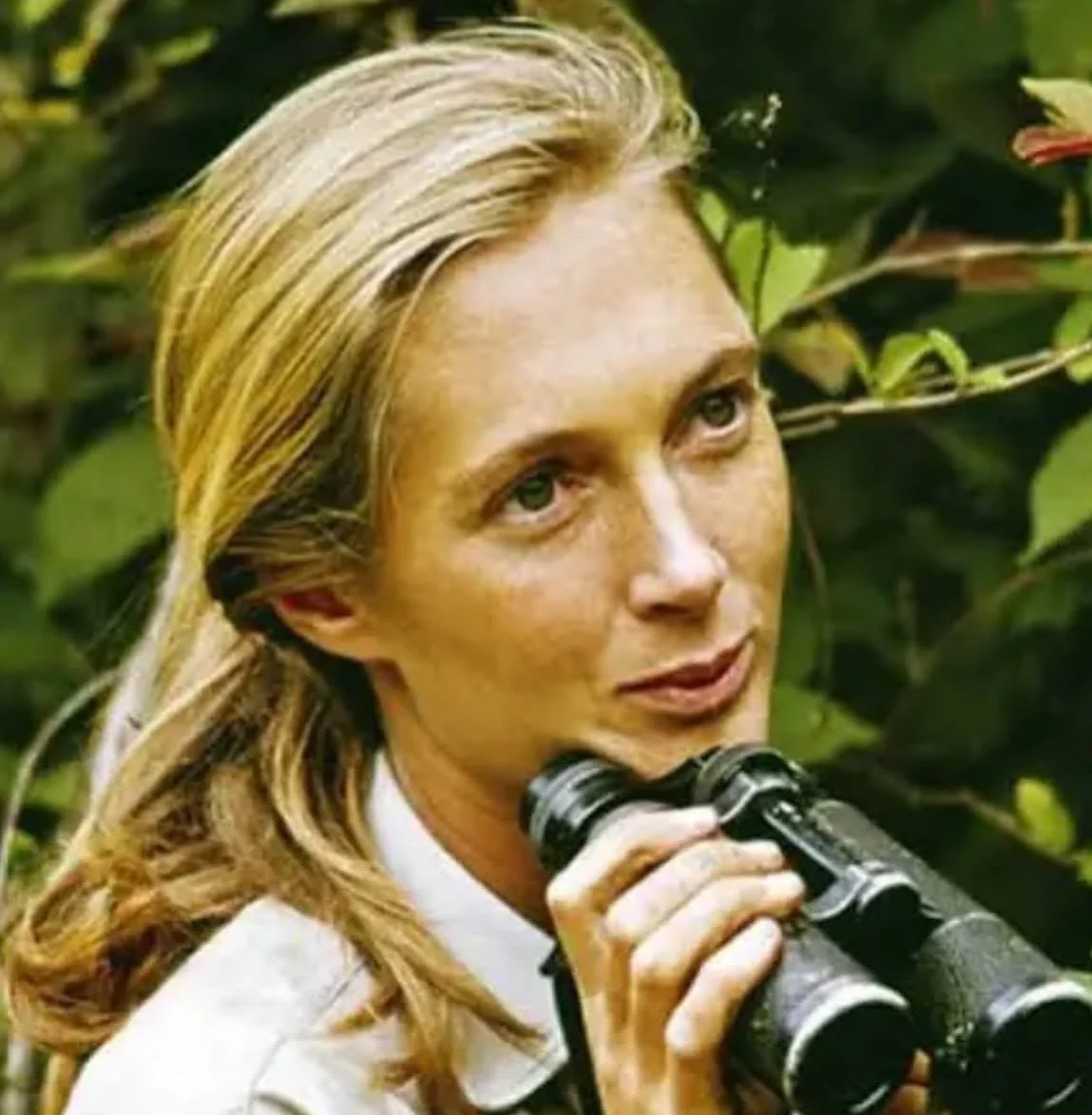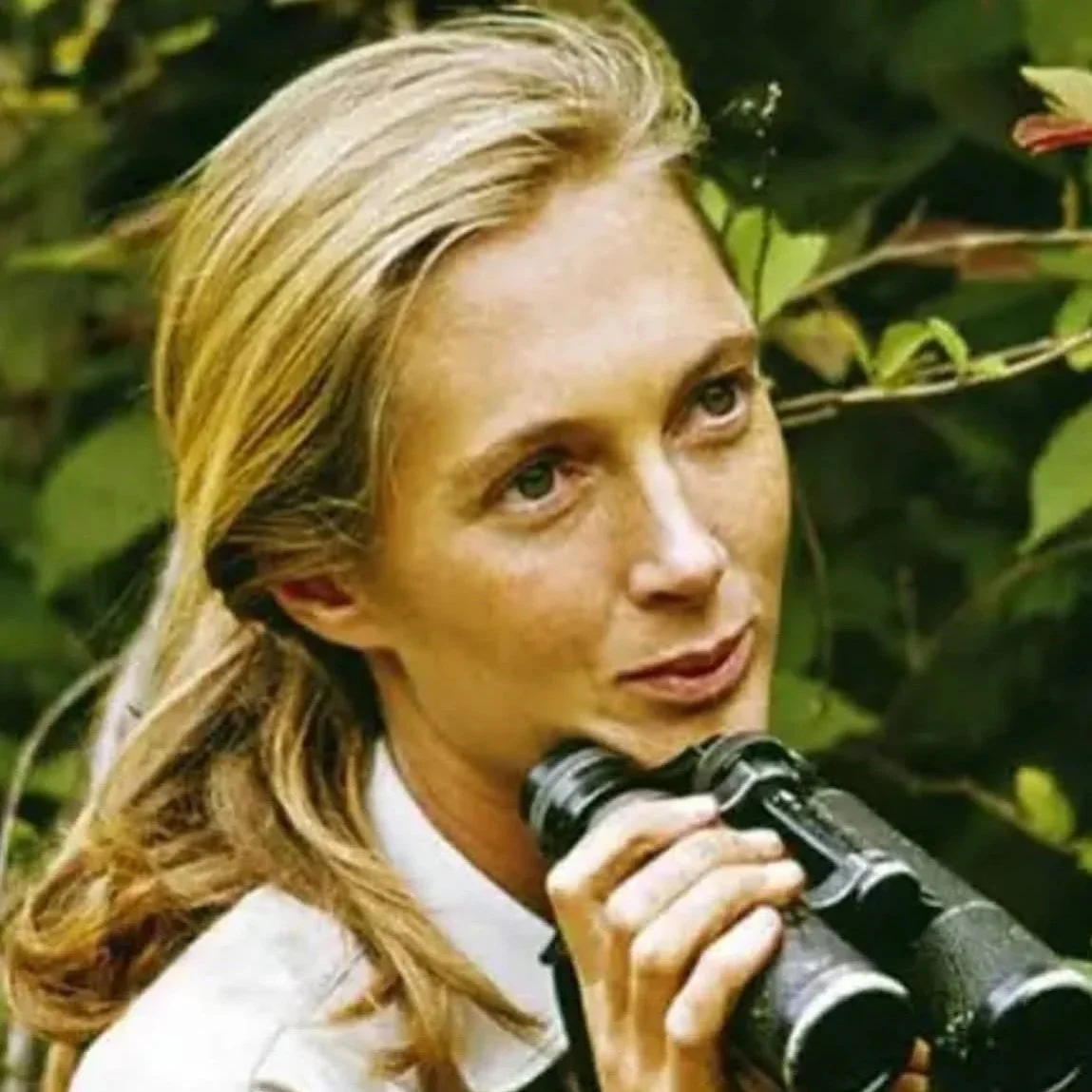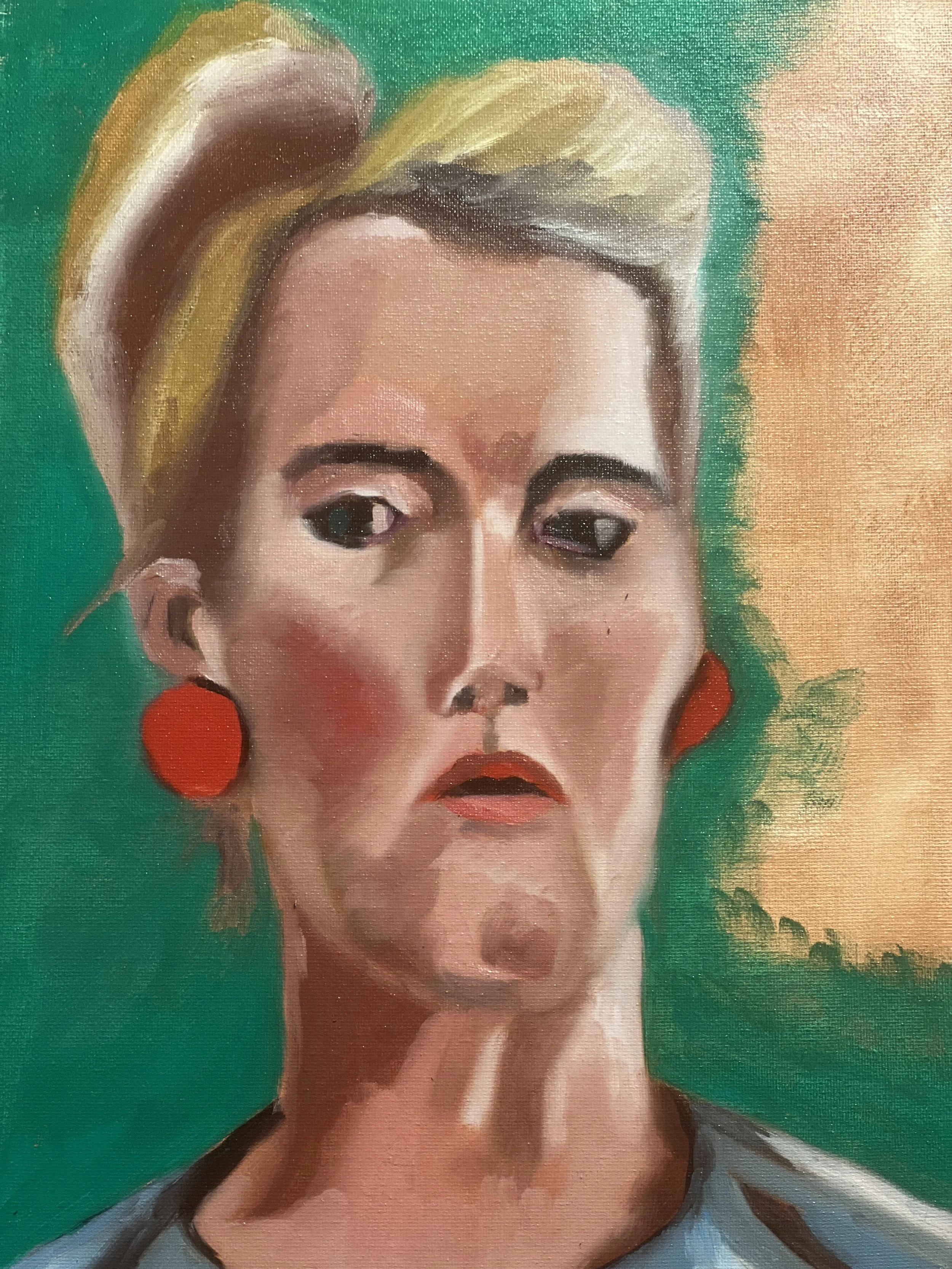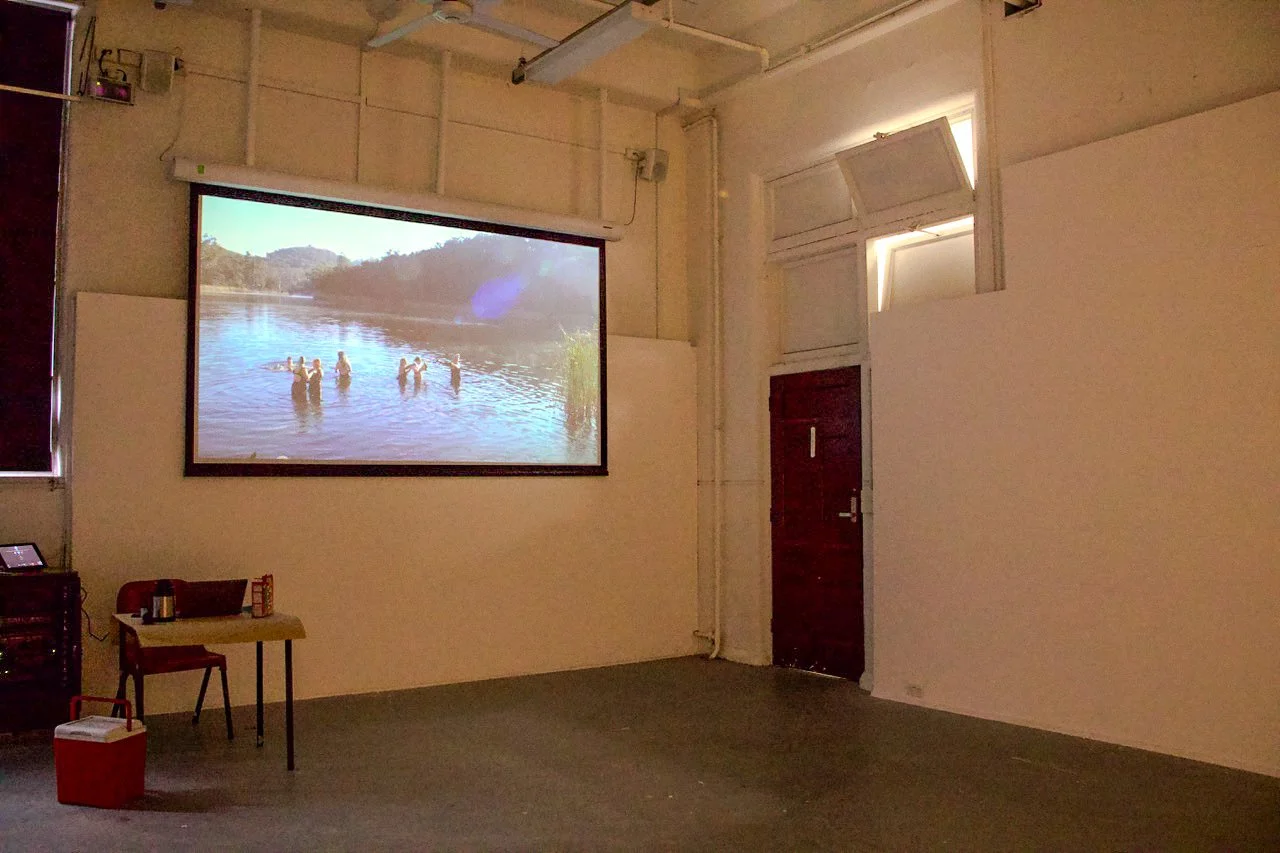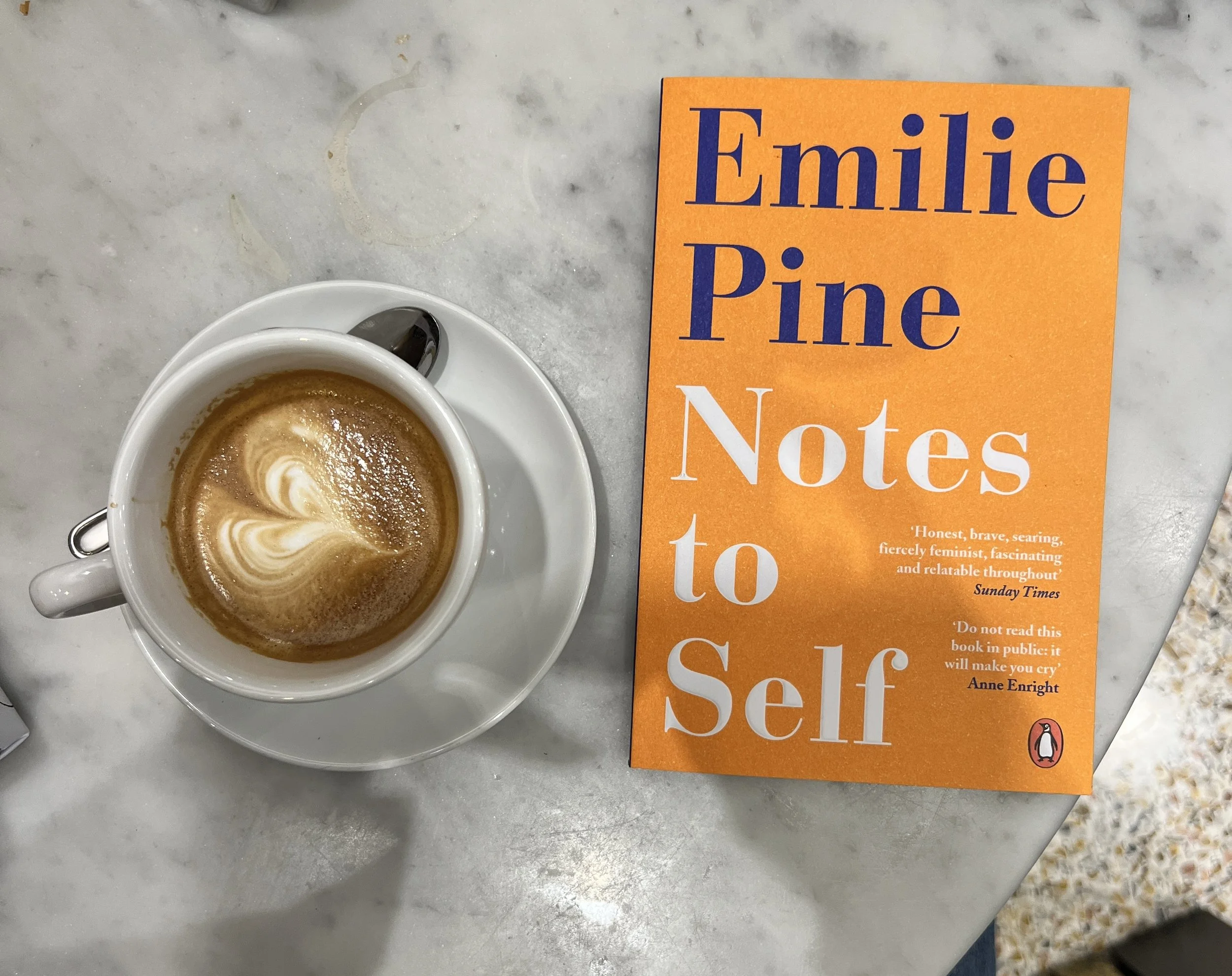In the Shadow of Mum
Yesterday, I exhibited 48 portraits as part of my Honours project, titled Talk to Me. It felt like giving birth to a giant, new, reassembled self. As I was installing the show, I saw an announcement that Jane Goodall had died. Jane was my childhood hero, introduced to me by Mum. She read In the Shadow of Man to me as a bedtime story. We shared in the trials and tribulations of the chimps and mourned their losses, particularly Flo, who was discovered by her infant, Flynn, lying face down in a stream of water. With adult vision, I see now that Mum, a child psychologist, was also sharing with me her learnings from a doctorate in attachment theory, and perhaps preparing me for her own death at the age of 40?
Not long after deinstalling the exhibition, I was consumed by a deep, bodily longing for Mum. This is strange because I have passed many milestones without her, almost forgetting her absence as I face up and soldier on. The experience of seeing my labour on the wall and all the painful iterations of self, unravelled me because I could see how much I have struggled with identity and love since I lost Mum at the age of 12. I was rattled out of my brave face and could see my vulnerability projected on the screen-sized wall of portraits.
Driving to a friend’s, in a manual car recently bequeathed to me by my aunt (Mum’s sister), I was feeling this strange, long-buried grief rise as I tried to negotiate gears and interpret signs appearing on the dashboard - S; SE. As I turned up Punt Road, the pain of missing her caved in my chest like both a cannonball weight and a deep void. At the age of 54, I called her on my imaginary car phone and began a conversation with her, explaining how much I wanted to feel her presence again, to have her wise counsel, to bask in the knowledge that I was seen and loved. The terror of losing my north star returned, and just at the moment, another symbol appeared on the dashboard - N. Suddenly, it all made sense. I need to sit in the silence of loss and I need to honour my grief.
There is one portrait amongst the 45 that I like the most because it shows my vulnerability and courage together. This is the face that I want to take forward, but to do so, I also need to confront the shadow of Mum and make peace with her absence. I feel that stepping into and out of her shadow will be my next project. I have a box of slides and her travel journal, documenting her adventures to Europe via Asia by boat in the sixties. This was before she married. I will start there, looking to see through her eyes and hear through her voice.
Methodology (in progress)
An in-progress explanation for how I work and my inspiration for figuration and memoir.
My practice-led research project focuses on portraiture as an auto-ethnographic methodology. I have chosen this creative methodological approach because it supports my research aims to examine the self and challenge traditional conventional narratives around gender and aging. Portraiture provides a complementary methodological framework because it offers a feminist, democratic, authentic and intrinsically trustworthy form of qualitative research (Straka, 2019).
Portraiture draws on ethnography and phenomenology to “describe, understand and interpret complex human experiences” (Lawrence-Lightfoot and Davis, 1997). I am interested in discovering and revealing artefacts of self and whether it is possible to convey the phenomenology of female aging against the backdrop of invisibility and shame in our society. Narrative self-portraits, through their inherent authenticity, present a challenge to the traditional meta-narratives of colonisation and patriarchy and may provide an opportunity for meaningful encounters and dialogue.
Drawing on contiguity and thematic-based methods for constructing narrative portraits, my methodology combines these two forms of praxis. (Jacobs & Rodrigues-Dorans, 2020), The first represents a contiguous method, using the same subject (me) and repeating a process (self-portraiture), in the same setting (my studio) throughout the year. The second thematic approach, influenced by Virginia Woolf (ref) and other writers (ref), relies on a stream of consciousness to identify patterns and abstract connections across my subject’s (my) lived experience. Connections are made through a mixed process of daydreaming, journaling and the documentation of items of interest recorded in a series of videos entitled Field Notes.
In a series of self-portraits, Mood Broads, I have chosen a smaller format, 60cm x 40cm, as it allows me to create more rapidly in oils and mimics the proportions of a passport or photo booth. Fig. 1 Mood Broads #40 (2025) shows an example of the author’s portraits. Capturing this portion of the body concentrates the focus on emotions that are most vividly portrayed in the face. My portraits draw on Freud’s psychoanalytic theories, the repetition of childhood loss of objects of affection and their guilty replacement with external objects, or, in some cases, the internalisation of desire, in the form of narcissism. I am also interested in the mirroring theories propagated by Freud (ref) and Lacan (ref) and expanded on by Winnicott (ref) in his theories on childhood development. Winnicott’s theory describes how humans develop as independent beings through the facial recognition of similarity and difference that we gain through interactions with our mothers (or significant caregivers).
I am influenced by other figurative artists who deal in affect, including Jenny Saville. My painterly process has included obscuring some areas and making others transparent, using different paint mediums to create layers and incorporating torn canvas and other materials. As humans, we are used to reading faces for signs; therefore, it seemed logical that the face could be a site of encounter. I have also used a uniform subject matter, which allows for a measure of affect and artistic development. It is intended that the small portraits will form other narratives what might these be? when curated and installed. I have created a total of 40 portraits. As artefacts of self, I am reluctant to assign these to failures and successes and have not yet decided on the presentation of the finished work.
Fig 2. 2643 Coffees (2025), provides an example of a narrative portrait created by the author.
In another narrative portrait, 2643 Coffees, influenced by Sophie Calle, I have chosen to portray my relationship as a core part of my self-identification. Refer to the type of relationship it is – long term partner. The work was inspired by the silk material I originally intended to mimic skin. Upon this fragile surface, I gradually hand-dyed segments of silk over a period of three weeks. Using silk paint and a stencil, I then recorded numbers to represent the number of coffees made for me over the years. The work symbolises time spent in a relationship, the acts that bind us, acts that sever us and the gradual fading of desire. Creating this work has enabled not only personal growth and reflection on the nature of this relationship but has also helped to engage with others. The work tells a story that I imagine many other women can relate to.
This combined methodological approach has parallels with Freud’s theories centring on the dynamic concept of self and dialectic between the Ego and the ID, desire and repression, with one central difference: there is no Super Ego to make conscious the unconscious and mediate in the formation of identity.{Freud, 1923 #72} It might be argued that the Super Ego acts as the Captain Self, described as one of the narrative voices employed by Virginia Woolf in Di Battista’s experimental biography, Imagining Virginia Woolf {Di Battista, 2009 #62}. I have attempted to bring the two methodological parts together by documenting and reflecting on my work on my website. When seen as a whole, it is easier to gain perspective on emerging themes and techniques and what this may mean in terms of both artistic and personal growth.
Relating this notion of the conscious and the pre-conscious to the research methodology for this project, perhaps this moderating voice is necessary for the synthesis to enable the development of the self? What other moderating influences become part of our self-development and integration with others? Methodologically speaking, this has presented a few extra challenges. Firstly, it is important to acknowledge that the creation of self-portraits and/or personal narratives involves the risk of reigniting trauma. Midway through the project, it became apparent that the process of creating multiple selves was leading to a type of disassociation and distance rather than the intended aims of self-integration and connection with others. It seemed not only helpful but necessary to return to a therapist to help unpack and make sense of the memories and emotions that surfaced in the studio. The therapeutic presence has now become part of my artistic process and research methodology.
Research Questions:
What happens when we add the self to portraiture as a methodological enquiry? How do we arrive at our narrative voice? How do we create a site of encounter with others? The final part of my research methodology involves the design of materials that prompt an interaction with the viewer. This is still in progress, but I am envisaging a mood questionnaire or coloured symbols that can be left to denote the affect response that the portraits leave.
Abstract
Summary of my research for RMIT Honours - it is very challenging coming up with an elevator pitch — especially when my themes and style are emerging. Any feedback is welcome and, if this sounds like complete nonsense please let me know.
This practice-led research positions the artist as an archaeologist of their unstable identity, exploring notions of self through portraiture and visual memoir. Working predominantly in oils, an experimental visual shorthand is being developed and refined that utilises painterly techniques of layering and erasure to reveal and disguise aspects of self. In the language of psychoanalysis, this painterly research uses the methods of mirroring, repetition and rupture to disrupt and reintegrate personal narratives. Collectively, these self-portraits illuminate multiple iconoclastic identities, creating a visual vocabulary that communicates affective states of transformation and becoming. Another critical method of the research is the creation of large-scale mixed-media narrative works that appropriate the literary tradition of memoir. These works centre on relationships and their role in shaping and reshaping our perceptions of self from childhood. I owe much of my inspiration to Virginia Woolf, whose writings still resonate in terms of their experimental nature and style of auto-fiction — part memoir, part essay and part fiction. Methodologically, this research is influenced by figurative painters such as Willem de Kooning, Paula Rega and Jenny Saville, as well as the performance-based narrative works of photographers Sophie Calle and Cindy Sherman. By working through the artefacts of self, this research aims to simulate a new site for healing and connection.
Field Notes: Expedition Pass Reservoir, Chewton, Dja Dja Wurrung Country
Women at Waterhole, Dja Dja Wurrung County, 2025, still from a Fields Notes Video
Sunday 1st June 2025
Time: 8.47 am - 9.49 am
Temperature: 4 degrees Celsius
On advice that they would be gathering there, I came to the water hole to observe the women swimming. It was fortunate advice as I saw a large group of women congregating by the bank of the reservoir when I arrived. I set up my camera in the hills above and watched them navigate the water and each other. I am unaware if they saw me. If they did, they did not appear concerned about my presence or being gazed upon.
My first impression was that, despite the chilly temperatures, they were not meeting for a competition. There were no obvious signs of an event, nor a time constraint. I could see no evidence of lanyards, markers or a location demarcated for a start and finish line.
On the contrary, the women appeared to be gathering for solace in the water and each other’s company. They presented as more interested in bonding than in competing to achieve a goal. There were no obvious signs of a goal at all….
I asked myself the question: Why did the women choose a painful sensory experience as a site for communing? How does this facilitate bonding? What follows are my direct observations that will require further research.
In the twenty-two-minute period, I observed a minimum of three embraces. These did not appear to be practical compensation for the frigid cold waters. Rather, they seemed to be obvious signs of pleasure in seeing one another, offering support and sharing one another’s experiences.
Even when there appeared to be physical discomfort or mental anguish, the women were laughing, and humour seemed to offer protection against the frigidity of the water. The laughter was quite noticeable, even from afar. The laughter increased with the pain of entering the water and rose to drown out the sound of birds.
The group appeared fluid, and there was no rigid structure for orientation. The women would congregate in pairs and smaller groups, and then these would break apart into new constellations.
There did not appear to be a leader. Initially, I thought it was one woman leading, but then another appeared to take her place, and then a different woman led the group into the water.
The more dominant women displayed greater amounts of vulnerability and allowed themselves to be approached for comfort and communality. Perhaps this is a sign of strength when it comes to survival?
Hypothesis: Women put themselves in extreme and painful situations, not to compete or fight with one another, but to bond through vulnerability. More observatory work is needed to demonstrate this theory, and it will be interesting to consider how this may differ from other life forms.
Personal Statement
This is my Artist’s Statement in Progress as I prepare a body of works for my Honours year at RMIT.
Me aged 21
I am thinking about female embodiment and transformation. Such existential musings ramp up as I age and start noticing the world differently. My attention has shifted, I have new priorities, and my body is changing. When I travel, I am no longer harassed as I was as a younger woman and can shift from being visible to invisible, depending on where I go. I am moving past being fertile and ripe to something more self-serving.
I am retracing my steps. This has included writing and returning to painting. I want to tell my story via portraiture and video works without making a judgment call on what it means to be a woman. If I catch a wave, I will let it carry me. I am interested in observing all the nuances of my shifting mood. I experiment with my mediums, layering, weathering and peeling away to discover what is beneath the surface.
At seventeen, I moved to Sydney to pursue a Fine Arts Degree. I was told that painting was “dead” and that Figurative painting was even deader. I was never taught how to paint and was strongly discouraged from pursuing my interest in the female figure by my male art teachers. On the other hand, I was welcome to be a life drawing model. These days, I am not listening to men who seek to control or confine me. Now that I have a voice again, I am a woman on fire.
Original Project Proposal RMIT Honours
This was my original project proposal for RMIT Honours. It has changed considerably along the way, but it is useful to have a reference point to see where I started and where I have ended up.
For my research topic, I plan to continue my studies in portraiture whilst exploring the theme of women transitioning to old age. I want to outline the mixed responses to ageing women and focus not only on women’s vulnerability to media messaging but also the strength that emerges when women are no longer celebrated as sexual objects but as holders of life lessons, familial relationships, expert knowledge and creativity.
In our society and media landscape, women’s bodies are often pathologised. The physical changes in women’s bodies during menopause are seized upon as something to medicate and fight against, whilst the ramping up of desire, autonomy and creativity is usually overlooked and rarely celebrated.
The Gisele Pelicot case in France highlights a perverse need to silence and subjugate a matriarchal woman. The uncomfortable pervasiveness of this crime is contrasted by the victim’s willingness to bear witness to the crimes reenacted via video footage. In doing so, she displaces the shame and asserts her power to speak out on behalf of other women.
Traditional portraiture has focussed on depicting younger women and the attributes of youth, beauty, innocence, fragility and fertility. Young women are ushered into being only when they are the subject of the male gaze.
For older women, the process of being seen is more complicated but ultimately more rewarding as it involves self-realisation. Men do not develop in the same way. Men do not have the same milestones of virility and are seen as inherently masculine at all stages of life.
Throughout the project, I will reference historical portraits, including works by female artists such as Frida Kahlo and Paula Modersohn-Becker, who both made autobiographical paintings proclaiming self-determination and autonomy over their bodies.
I will contrast autobiographical works by female artists to historical works by their male counterparts, depicting ageing male figures in grand narratives involving battles or quests for knowledge.
There is, a growing tide of literature that recognises the power women can seize in this moment of transition. Miranda July’s All Fours is but one example.
